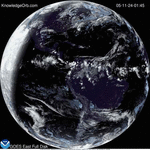A multinational, multi-institution team of researchers led by UA scientist Ian Crossfield has found a star with three planets, one of which may have temperatures moderate enough for liquid water — and maybe even life to exist. The Kepler spacecraft may be damaged but the extended mission is yielding results.
The star, EPIC 201367065, is a cool red M-dwarf about half the size and mass of our own sun. At a distance of 150 light-years, the star ranks among the top 10 nearest stars known to have transiting planets. The star’s proximity means it is bright enough for astronomers to study the planets’ atmospheres, to determine whether they are like Earth’s atmosphere and possibly conducive to life.
The smallest and outermost planet, at 1.5 Earth radii, orbits far enough from its host star that it receives levels of light from its star similar to those received by Earth from the sun, said UC Berkeley graduate student Erik Petigura. …”Most planets we have found to date are scorched. This system is the closest star with lukewarm transiting planets,” Petigura said. “There is a very real possibility that the outermost planet is rocky like Earth, which means this planet could have the right temperature to support liquid water oceans.”
The discovery is all the more remarkable, he said, because the Kepler telescope lost two reaction wheels that kept it pointing at a fixed spot in space.Kepler was reborn in 2014 as “K2” with a clever strategy of pointing the telescope in the plane of Earth’s orbit, the ecliptic, to stabilize the spacecraft.
“This discovery proves that K2, despite being somewhat compromised, can still find exciting and scientifically compelling planets,” Petigura said. “This ingenious new use of Kepler is a testament to the ingenuity of the scientists and engineers at NASA. This discovery shows that Kepler can still do great science.”
The original Kepler mission found thousands of small planets, but most of them were too faint and far away to assess their density and composition and thus determine whether they were high-density, rocky planets like Earth or puffy, low-density planets like Uranus and Neptune. Because the star EPIC-201 is nearby, these mass measurements are possible. The host star, an M-dwarf, is less intrinsically bright than the sun, which means that its planets can reside close to the host-star and still enjoy lukewarm temperatures.
According to [University of Hawaii astronomer Andrew Howard], the system most like that of EPIC-201 is Kepler-138, an M-dwarf star with three planets of similar size, though none are in the habitable zone.
Article Source paper (http://arxiv.org/pdf/1501.03798v1) describing the find by astronomers at the UA, the University of California, Berkeley, the University of Hawaii, Manoa, and other institutions.








